
The shark is a moth of the family Noctuidae. The species was first described by Carl Linnaeus in his landmark 1758 10th edition of Systema Naturae.

Cucullia chamomillae, the chamomile shark, is a moth of the family Noctuidae. The species was first described by Michael Denis and Ignaz Schiffermüller in 1775. It is found in Central Europe, Southern Europe, the Near East and North Africa.

Cucullia is a genus of moths of the family Noctuidae. The genus was erected by Franz von Paula Schrank in 1802.

Zealandia pustulata is a species of fern native to eastern Australia and New Zealand. It is commonly referred to as kangaroo fern because of its mature leaves tend to resemble the shape of a kangaroo foot. It is also referred to as hound's tongue, and as kōwaowao and pāraharaha in Māori.

Cucullia lactucae, the lettuce shark, is a moth of the family Noctuidae. The species was first described by Michael Denis and Ignaz Schiffermüller in 1775. It is found in most of Europe, Turkey, the Caucasus and east across the Palearctic to the Altai mountains. In the Alps it rises to 1,800 metres (5,900 ft). It is found mainly in barren places, on weeds and debris and scree corridors on slopes, shrubby edges and in vineyards, gardens and parks.

Cucullia calendulae is a moth of the family Noctuidae. It is widespread in all parts of the Mediterranean Basin, from northern Africa to Saudi Arabia, Lebanon, Jordan, Israel, Transcaucasus, Turkmenistan, Iran and Afghanistan.
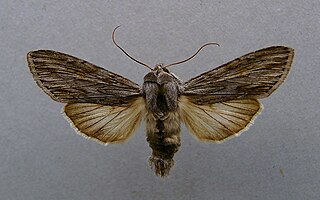
Cucullia lucifuga is a species of moth of the family Noctuidae. It is found in north, central and southern Europe east to Japan. It is also present in Tibet and Armenia.

Cucullia absinthii, the wormwood, is a moth of the family Noctuidae. The species was first described by Carl Linnaeus in 1761. It is found from Europe to the Caucasus, Turkey, northern Iran, western Siberia, the Altai mountains, Tien-Shan and Tarbagatai.
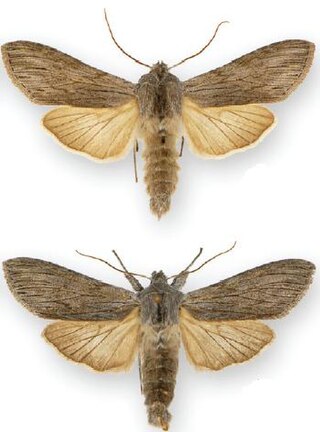
Cucullia intermedia, the dusky hooded owlet, intermediate cucullia, goldenrod cutworm or intermediate hooded owlet, is a moth of the family Noctuidae. The species was first described by Adolph Speyer in 1870. It is found from coast to coast across southern Canada and the northern United States, south in the west to California and to Pennsylvania in the east. In the Rocky Mountains it is found south to the White Mountains in east-central Arizona and occurs commonly in Utah, Colorado and north-eastern Nevada.
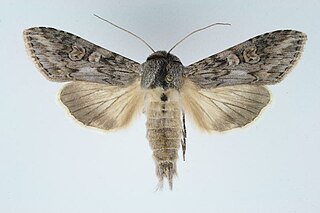
Cucullia artemisiae, or scarce wormwood, is a moth of the family Noctuidae. The species was first described by Johann Siegfried Hufnagel in 1766. It is found from central and southern Europe to Turkey and across the Palearctic to western Siberia, Central Asia, Manchuria, the Korean Peninsula and Japan.

Cucullia gnaphalii, the cudweed, is a moth of the family Noctuidae. It is found from most of Europe to Turkey, Transcaucasia, Mongolia and Sayan.
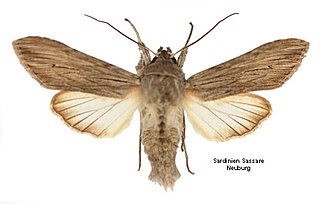
Cucullia tanaceti is a moth of the family Noctuidae. The species was first described by Michael Denis and Ignaz Schiffermüller in 1775.

Cucullia splendida is a species of moth of the family Noctuidae first described by Caspar Stoll in 1782. It is found in Russia and parts of Africa, Asia and America.

Zelentia pustulata is a species of sea slug, an aeolid nudibranch, a marine gastropod mollusc in the family Trinchesiidae.
Cucullia eulepis is a species of moth in the family Noctuidae. It is found in North America.
Cucullia omissa, known generally as the omitted cucullia or Alberta falconer, is a species of moth in the family Noctuidae. It is found in North America.
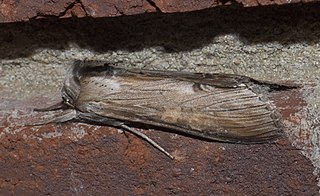
Cucullia asteroides, known generally as the goldenrod hooded owlet or asteroid moth, is a species of moth in the family Noctuidae. It is found in North America.

Strombosia pustulata is a species of tree in the family Olacaceae. It is native to the rainforests of tropical West and Central Africa. Common names for this tree include itako in Nigeria, afina in Ghana, poé in Abé spoken in Côte d'Ivoire and mba esogo in Equatorial Guinea.

Cucullia praecana is a moth belonging to the family Noctuidae. The species was first described by Eduard Friedrich Eversmann in 1844.
Cucullia balsamitae is a moth belonging to the family Noctuidae. The species was first described by Jean Baptiste Boisduval in 1840.


















